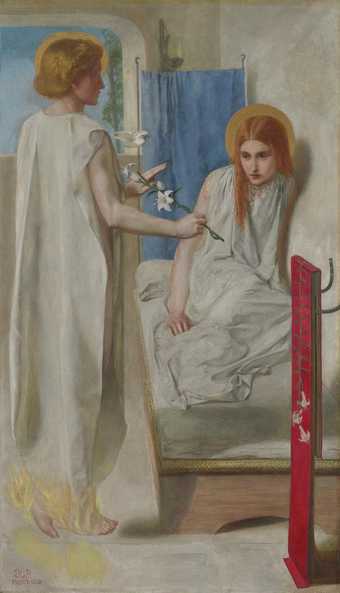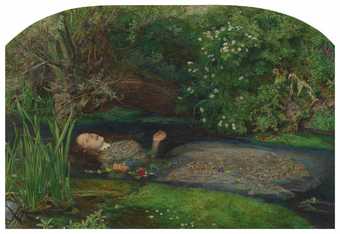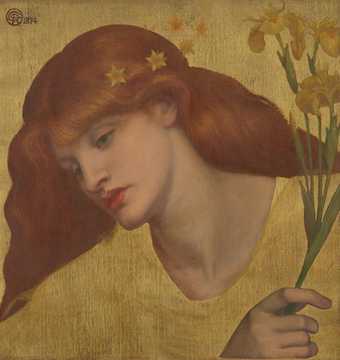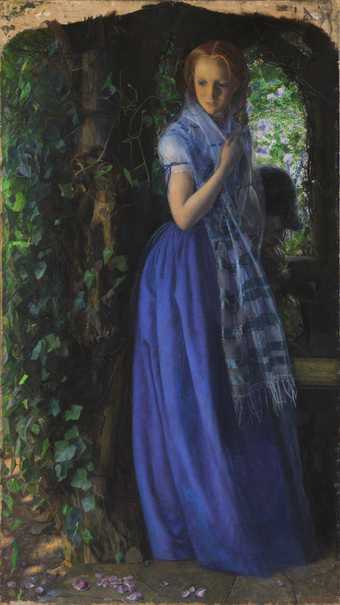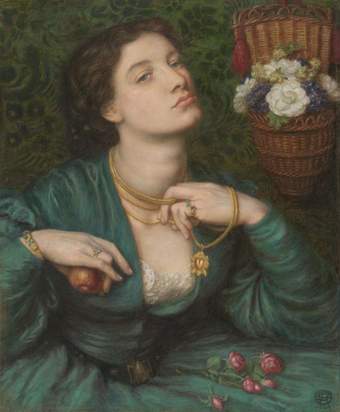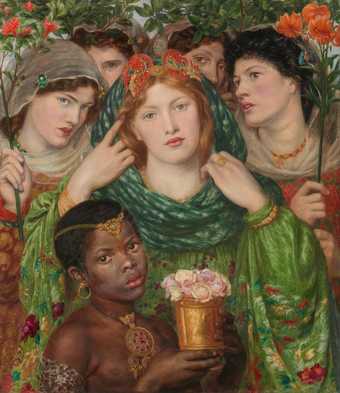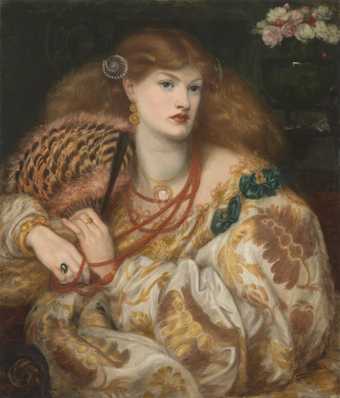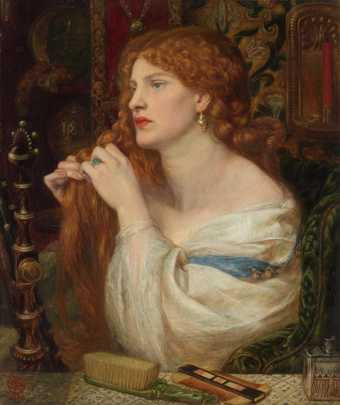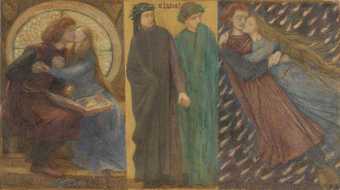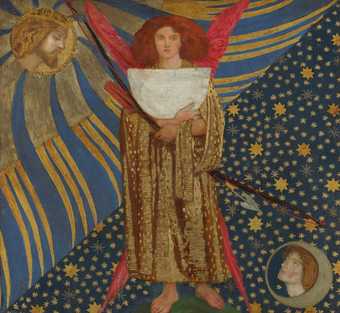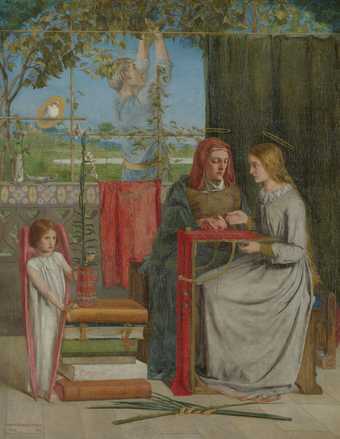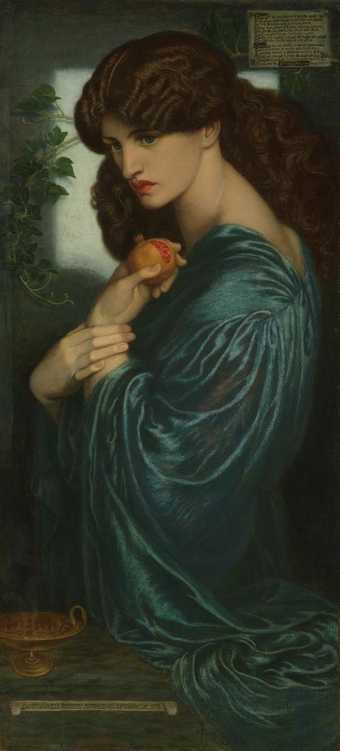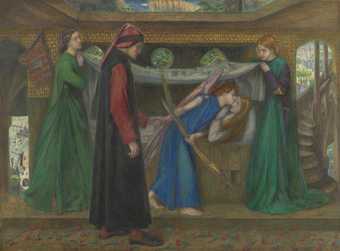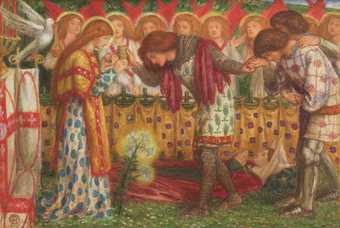
In Tate Britain
Exhibition
- Artist
- Dante Gabriel Rossetti 1828–1882
- Medium
- Oil paint on canvas
- Dimensions
- Support: 864 × 660 mm
frame: 1214 × 1018 × 87 mm - Collection
- Tate
- Acquisition
- Presented by Georgiana, Baroness Mount-Temple in memory of her husband, Francis, Baron Mount-Temple 1889
- Reference
- N01279
Summary
Rossetti draws a parallel in this picture between the Italian poet Dante's despair at the death of his beloved Beatrice and his own grief at the death of his wife Elizabeth Siddal, who died on 11 February 1862. Dante Alighieri (1265-1321) recounted the story of his unrequited love and subsequent mourning for Beatrice Portinari in the Vita Nuova. This was Rossetti's first English translation and appeared in 1864 as part of his own publication, The Early Italian Poets.
The picture is a portrait of Elizabeth Siddall in the character of Beatrice. It has a hazy, transcendental quality, giving the sensation of a dream or vision, and is filled with symbolic references. Rossetti intended to represent her, not at the moment of death, but transformed by a 'sudden spiritual transfiguration' (Rossetti, in a letter of 1873, quoted in Wilson, p.86). She is posed in an attitude of ecstasy, with her hands before her and her lips parted, as if she is about to receive Communion. According to Rossetti's friend F.G. Stephens, the grey and green of her dress signify 'the colours of hope and sorrow as well as of love and life' ('Beata Beatrix by Dante Gabriel Rossetti', Portfolio, vol.22, 1891, p.46).
In the background of the picture the shadowy figure of Dante looks across at Love, portrayed as an angel and holding in her palm the flickering flame of Beatrice's life. In the distance the Ponte Vecchio signifies the city of Florence, the setting for Dante's story. Beatrice's impending death is evoked by the dove - symbol of the holy spirit - which descends towards her, an opium poppy in its beak. This is also a reference to the death of Elizabeth Siddall, known affectionately by Rossetti as 'The Dove', and who took her own life with an overdose of laudanum. Both the dove and the figure of Love are red, the colour of passion, yet Rossetti envisaged the bird as a messenger, not of love, but of death. Beatrice's death, which occurred at nine o'clock on 9th June 1290, is foreseen in the sundial which casts its shadow over the number nine. The picture frame, which was designed by Rossetti, has further references to death and mourning, including the date of Beatrice's death and a phrase from Lamentations 1:1, quoted by Dante in the Vita Nuova: 'Quomodo sedet sola civitas' ('how doth the city sit solitary'), referring to the mourning of Beatrice's death throughout the city of Florence.
Further reading:
Leslie Parris (ed.), The Pre-Raphaelites, exhibition catalogue, Tate Gallery, London 1984, reprinted 1994, p.209; reproduced p.208, in colour.
Virginia Surtees, The Paintings and Drawings of Dante Gabriel Rossetti (1828-1882): A Catalogue Raisonné, 2 vols., Oxford 1971, pp.93-4, no.168, reproduced pl.238.
Andrew Wilton and Robert Upstone (eds), The Age of Rossetti, Burne-Jones & Watts: Symbolism in Britain 1860-1910, exhibition catalogue, Tate Gallery, London 1997, pp.154-7, no.44; reproduced p.154, in colour.
Frances Fowle
7 December 2000
Does this text contain inaccurate information or language that you feel we should improve or change? We would like to hear from you.
Display caption
Rossetti’s inspiration was Dante’s La Vita Nuova (‘The New Life’), which explores the Italian poet’s idealised love for Beatrice and her premature death. As an omen of death, a bird drops a white poppy between her open hands. In the background the ghostly Dante gazes towards the figure of Love. Rossetti viewed this as a memorial to his wife and the model for Beatrice, Elizabeth Siddall, who had died in 1862. Rossetti had buried the manuscripts of his unpublished poems including On the Vita Nuova of Dante with his wife but, in a macabre twist, retrieved and published them in 1870.
Gallery label, November 2016
Does this text contain inaccurate information or language that you feel we should improve or change? We would like to hear from you.
Explore
- architecture(30,960)
-
- bridges and viaducts(4,123)
-
- bridge(3,989)
- townscapes / man-made features(21,603)
-
- townscape, distant(8,109)
- characters(438)
-
- Beatrice(14)
- scientific and measuring(791)
-
- sundial(19)
- drug-induced state(6)
- trance(6)
- individuals: female(1,698)
- individuals: male(1,841)
- Italy(4,473)
- mysticism(2,612)
-
- transfiguration(6)
- vision(678)
- birth to death(1,472)
- birth to death(109)
-
- death - dove(1)
- death - poppy(3)
- love - angel(5)
- love - flame(1)
You might like
-
Dante Gabriel Rossetti Ecce Ancilla Domini! (The Annunciation)
1849–50 -
Sir John Everett Millais, Bt Ophelia
1851–2 -
Dante Gabriel Rossetti Sancta Lilias
1874 -
Arthur Hughes April Love
1855–6 -
Dante Gabriel Rossetti Monna Pomona
1864 -
Dante Gabriel Rossetti The Beloved (‘The Bride’)
1865–6 -
Dante Gabriel Rossetti Monna Vanna
1866 -
Dante Gabriel Rossetti Aurelia (Fazio’s Mistress)
1863–1873 -
Dante Gabriel Rossetti Paolo and Francesca da Rimini
1855 -
Dante Gabriel Rossetti Dantis Amor
1860 -
Dante Gabriel Rossetti St Catherine
1857 -
Dante Gabriel Rossetti The Girlhood of Mary Virgin
1848–9 -
Dante Gabriel Rossetti Proserpine
1874 -
Dante Gabriel Rossetti Dante’s Dream at the Time of the Death of Beatrice
1856

